As a kid growing up in the 50ís I remember the ads in the back of Field and Stream and Sports Afield magazines depicting monstrous lake trout as long as your leg. I dreamed about a trip to catch one of those big char. TTG contributor, Mike Sadar, recently made the trip. Read his account of traveling to the top of the world to tangle with the biggest lakers in the world!
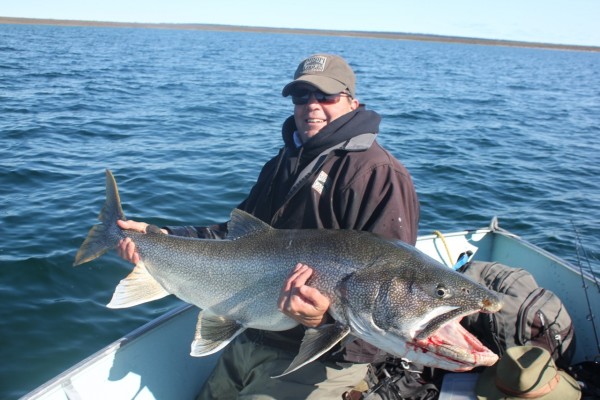
A big male laker from GBL.
Click to view image
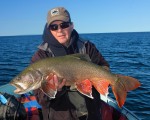
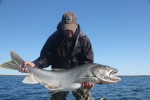
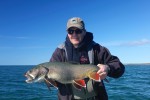
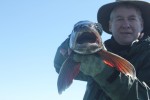
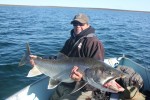
The Lake trout is top predator of the trout and char family. It is the beast that lives in the depths of the biggest and deepest freshwater lakes across the globe. It is capable of living in the coldest of waters and has the longevity to outlive virtually all other trout species. Since trout have indeterminate growth, once a lake trout is able to grow big enough to eat other fish, it really can grow big, and sometimes fast! That being said, the lake trout offers most trophy trout anglers a consistent opportunity to pursue specimens that exceed 20-pounds south of the 48th parallel and in many lakes, much bigger than that. In fact, there are many lakes in the Western United States where specimens that exceed the awesome mark of 50 pounds have been documented. That is the size of lake trout that I have set as a size goal for that species in and I have spent what seems to be an eternity of days chasing after them!
What I have found out with lake trout in the westís best laker lakes that for every twenty pound fish, one has to catch many ten pound fish. And for every 30 pound fish, one goes through many twenty pounders. Once the size exceeds about 35-pounds, the pursuit becomes a lottery of sort, as you might be the lucky one to catch a 40 or 50 pound monster, or one might go through their entire fishing career never able to hold such a giant. While 41-pounds has been my biggest lake trout in more than 35-years of dedicated fishing for them south of the border, I also know the odds can be tilted by looking to the North, the far north!
There are a handful of lakes in Canada that hold true behemoth Lake trout. Lakes like Selwyn, Athabaska, Wollaston, Kasba, Neutin, Lac La Marte, all have consistently produced species that exceed 50 pounds and some have even produced much bigger. Even these lakes will only produce one or two specimens in a given year, so it is still a lottery of sorts to land that 50 pound monster. There is one exception, a lake where numerous 50-pound plus lake trout are landed each year. It is a massive lake, Great Bear Lake.
Great Bear Lake, or GBL has been the place where the odds of catching that 50-pound lake trout are indeed a real possibility. The lake is the forth largest in North America, an inland sea where one cannot see the other side in open water. One could travel more than 400 miles to go from one shore to the other, and in such a huge body of water, it has its own unique ecosystems and genetics that have allowed for gigantic lake trout to grow. Before our trip to GBL more than two dozen 50-pound lake trout had been caught for the season, with the biggest documented fish this year exceeding the 70-pound mark. This indeed is the place to be for big lake trout.
While our tripís primary focus was to catch red arctic char from the Tree River, the other part of the trip was to fish GBL for trophy lake trout. Our trip was split to fish three and a half days at each, and we found the Tree River to be a challenging but Awesome trip. Once that part of the trip came to a conclusion, we changed our focus to GBLís Lake Trout.
The time of year at GBL does have an impact on chances when to catch the biggest lake trout. Early in the year is the prime time, as the lake trout are forced into the shallows, where the water warms the fastest and draws in the schools of bait. The lake trout follow into these shallows where the the food is abundant and these beasts can also catch some sun and warm up from the long arctic winter. As the days lengthen, the water warms to the point that the lake trout will move into slightly deeper water, depths that are between 20 and 50 feet. For this lake, 50 feet is about as deep as the guides fish. This means that the fish are always reachable without the use of down-rigging equipment and they can be caught by numerous means, including jigging, fly fishing, and trolling without weights.
The end of the season sees the lake trout moving to slightly shallower water, to depths where they can be spotted if one choses to lean over the boat and stare into the water. The fish are interested in spawning and will look for reefs and shoals that are between 6 and 20 feet deep. The end of the season also brings uncertain weather, and we found this to be the case during our week. We had days where the wind kept us close to shore and in sheltered areas. We always caught fish, but with only a few exceptions, most of the fish were under 10-pounds.
We found the fish to be close to rocky shoals the majority of time, and focus was to cover bottom structure that ranged from gravel to rocks up to the size of watermelons. It is this structure where the lake trout begin to think about spawning and will start to become more territorial. With the lake water so clear, we were able to see bottom down to about 27 feet of water, which allows us to see the bottom most of the time. We often saw lake trout swim off, and some times the boat did spook the fish. To alleviate that, I would cast at a 45-degree angle from the centerline of the boats direction and allow my jig to swing into a standard trolling position. This would allow fish to see the jig from a great distance and then they would begin to follow or strike the jig without being spooked by the boat.
Our group fished either of two ways. Some of us focused on trolling large gitzet jigs. These jigs were 6-10 inches long and would be over a 1-2 ounce jig hook with a large gap. The size of the gitzet would hide the hook barb and when the fish would bite, it was into a soft substance. If the fish missed the strike, it often would strike again. It was common to have several strikes before finally hooking the fish.
The other way was to cast and troll large streamers. The fish on GBL like to follow flies and lures for long distances before deciding to strike. Thus, casting and retrieving a fly was not effective, as the fish would follow the fly to the boat, and once the boat was spotted, the fish would spook and swim away. Thus, trolling flies was much more effective, and fish as large as 36-pounds were taken in this manner. In fact the flies were probably the most effective pattern, as they were tied in very large sizes, and presented a different and large profile that the fish had not seen.
Both methods of casting and trolling jigs and trolling flies proved to be effective at GBL. We did observe fish follow the lures for several hundred yards before either losing interest, or finally deciding to strike the jig. To make them decide a little quicker, I often changed direction, speed, and made some significant darting motions to the jig. This often triggered the strikes.
Personally, I caught one monster on this trip. Fishing had been very slow and we moved to a new area. As we slowed down to start trolling, I cast the jig far off the side of the boat, to water were fish could not the boatís profile. As the jig would swing back to the boat, a monster lake trout inhaled the 8-inch offering. Several minutes later, the fish was close to the boat. It was a big fish, and I thought it was in the 30-pound class, maybe, but the water was so clear that the fish was much farther away than I estimated. Finally, when the fish was within a foot of the surface of the water, I could see it had significant length and a gigantic head. We slipped the net under the big fish and he was landed. We all guessed on what it weighed, but when it was finally hoisted up, the guide stated 40-pounds on the nose. We then took a few quick pictures, made an accurate measurement of 45-inches and then released the beast back into his home waters to grow even bigger.
Others in our group caught some very nice fish. Brian Harmon, a friend from Loveland, Colorado had the best luck, landing three monsters that topped the 30 pounds. Several of these fish were completely empty and had these fish had a good meal before striking the lures, they might have topped the 40 pound mark as well. The biggest fish caught on a fly was 36-pounds and measured 44-inches. While these did not top that 50-pound milestone, they were certainly life best catches for their anglers.
Regarding these monster lakers, these are all referred to as the grey or blueback lake trout. This is but one species in GBL, but there are really at least seven distinct species of lake trout in GBL. Another species that was present is the redfin or butterfly lake trout. This species is only found is very specific areas of the lake. The redfin only grows to a top weight of about 20-pounds, but a species of this weight will be over 50-years old. These slow growers exhibit their age by the size of their fins, and in particular their pectoral fins. For these fish, the pectoral fins are about the same length as the height of the fish at its deepest girth, which makes them huge. In addition, they turn blood red. The Redfin also has thousands of small white spots.
I caught several redfin lake trout with my biggest being around 15-pounds. The fish have a heavy profile, although they did not exceed 30-31 inches in length. They were the most beautiful lake trout I have ever seen anywhere, and that includes thousands of lakers over my lifetime. I have never seen a mount of a redfin lake trout, but I plan to have a reproduction done at some point. This was a big bonus that was not expected from GBL!
We only caught a handful of fish from GBL, and of all the guests, the biggest fish landed was 45-pounds. Weather was challenging for our days there, with lots of rain and wind. This kept us from going to remote places and tight to spots close to the lodge, where the pressure on the fish is intense all summer long.
Even though GBL is remote, and the lodge is on a remote part of the lake, the anglers throughout the summer will typically fish the same spots repeatedly. Lake trout also tend to be territorial, and in my experience, big lake trout are even more territorial. That being said, these fish are still exposed to fishing pressure and this needs to be considered when planning a trip to this lake. We address the issue using huge gitzet gigs and flies, something that the fish had not been exposed. We did catch the majority of fish and big fish using these two patterns. Other guests fished the same spoons and flatfish that were used all year long and they did catch fish, but in lower numbers. This may not be an issue on the early part of the season, but it is definitely an issue as the season comes to an end.
I also found it difficult to persuade our guide to try some different techniques, and this is one of those issues that is common when visiting lodges. The guides do want their clients to do well and from their perspective, they are going to push what works for them. However, if what they suggest is not working well, I tend to push for out of the box ideas, which are often ideas that have seen success elsewhere. It took some lobbying, but by the end of the trip, our guide did see that other techniques will work. Thus, I try not to be shy, and not too patient. When fishing a remote lake such as GBL, time matters, and I tend to have less patience with techniques that are not producing. Over the years, I have found this is a great approach until one finds the pattern that produces best.
GBL is such a large lake, that it is difficult to reach much of this lake by boat. Thus, Plummerís Lodge offers numerous flyouts to different spots on the lake that have been proven to be good. Some spots have large numbers of fish, and others have very large fish. Unfortunately, these flyouts are not included in the package price, and they are very expensive. We did choose one flyout, and it was the cheapest of them all, but it was still over priced at $800 per person! That being said, Plummerís will strongly encourage anglers to go to these spots to increase the chance of catching a big fish and I have found that at more than 70-percent of the 50-pound lake trout were caught on these flyouts. Thus, to really increase the odds, this is one means to further push them on your favor, but it will be an additional 50-percent in cost to do so.
Plummers also offers some other lodges where fishing direct from the lodge is good for big fish. Trophy lodge is one of these lodges and is located on the West end of the big lake. This lake is particularly good early in the season for big lake trout. They also offer another remote lodge that is a do it yourself lodge for a much lower price. This one is intriguing as it would require sonar (which is included) and a map. With GPS and some pre-trip study, this might be the best solution for giant lake trout.
If or when I return to this freshwater ocean, I will do so with a primary focus on that 50-pound plus lake trout. While this was a super trip in that the arctic char was my primary focus, I cannot complain too much landing a 40-pound lake trout and along with some beautiful redfin lakers. When I return it will be the earliest possible time of the season. This will offer several advantages. First, the fish have not had any pressure. Second, they are pushed way up into the shallows where they can be caught on light tackle of casting with flies. Third, I will probably choose one of the established remote lodges, where known big fish spots can be reached by boat. At all cost, I will avoid going to the main lodge because there are far too many people (up to 40) and far too much pressure on the ďlocalĒ fish. Regardless of these issues, this is the body of water to fish for the biggest of all trout and char!